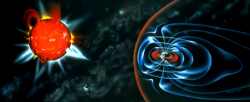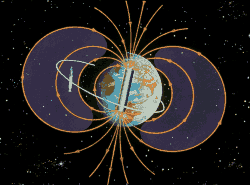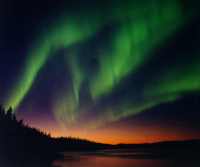Storms In Space
By Ramon E. Lopez
Department of Astronomy, University of Maryland, College Park
 |
| |
Figure 1. The space near Earth is controlled by
Earth's magnetic field. The solar wind pushes Earth's field into
a comet-shaped object called the magnetosphere.
Image credit: of the Space Science Institute.
Artwork by Steve
Mercer. |
|
When we think of weather, we normally think about rain or shine,
or snow during the winter months. However, there is another kind of weather
that is beginning
to make an impact on people's lives: space weather. What is space weather,
and how does it affect us here on Earth? To answer these questions we have
to begin with a few basic aspects of the space environment.
1. Space is not empty. Most people find this statement surprising since we
generally think of space as a vacuum. To a certain degree this is true, but
space is not an absolute vacuum. It is filled with very thin electrically charged
gas consisting mostly of protons and electrons. The gas is so thin that a thimbleful
of air holds as many atoms as does a cube 2 miles on each side in space. Pretty
thin, but it is still there.
 |
| |
Figure 2. Earth's magnetic field traps energetic
particles to form donut- shaped belts around Earth called the
Van Allen radiation belts. |
|
2. Earth is a magnet. Earth's magnetism is what makes a compass
needle point north (or south), and it is this same magnetic field that plays
an important
part in space weather. Since the gases in space are electrically charged, magnetic
fields can influence their motion, even trapping high-energy particles (like
in the Van Allen radiation belts in Figure 2). Also, as electrically charged
gases flow past magnetic fields, they generate electric currents.
3. The Sun produces an electrically charged gas called the
solar wind that flows out from the Sun in all directions. When this solar
wind hits Earth's
magnetic field, it creates a comet-shaped magnetic cavity called the magnetosphere
(see Figure 1). Electric currents are carried by the thin gas in space and
flow down along Earth's magnetic field into our atmosphere. If these currents
are intense enough, the atmosphere glows like a neon tube. This glow is the
mysterious aurora, which appears both in the northern and southern polar regions.
During big magnetic storms the aurora can be seen in Washington.
 |
| |
An aurora photographed in Alaska on September
6, 1996. Photo copyright Jan
Curtis. |
|
So the space environment near Earth is dominated by Earth's magnetic field, but
powered by the solar wind. And as in any environment, there can be disturbances
which we can call "storms." Storms in the space environment are caused
by gusts of solar wind that strike the magnetosphere. The magnetic field of the
solar wind also plays a big role
in storms by becoming connected to Earth's magnetic field. This allows the solar
wind energy to get into the magnetosphere. The extra burst of energy drives big
currents (millions of amps) in Earth's upper atmosphere, creates brilliant auroras,
and causes fluctuations in the magnetic field. It also energizes the protons
and electrons trapped in the
Earth's magnetic field, raising the radiation levels in space.
How do these "magnetic storms" impact us on Earth?
To begin, more of what we do on Earth depends on our space systems. Just
think about telephone
and television. They both depend to an amazing degree on satellites to beam
signals back and forth. During magnetic storms, communication satellites can
be damaged by the radiation these storms produce. On January 11, 1997, the
Telstar 401 satellite was lost during the height of a major magnetic storm
that started a day earlier. The traffic Telstar 401 was carrying had to be
quickly rerouted, and the satellite itself never recovered. Several other satellites
have been lost during magnetic storms. At more than $200 million per lost satellite,
big magnetic storms can be expensive.
Magnetic storms can also directly disrupt electrical power here on Earth,
causing blackouts over large regions. In March 1989, major storm caused 1/3
of Canada and part of upstate New York to lose power. Damages ran into the
millions. Some experts think that now we may be more vulnerable to big magnetic
storms because our electrical power grids are becoming more interconnected
to improve efficiency.
While big, dramatic events as described above are rare, space
weather is something that will have an increasing impact on our lives. We
are becoming more dependent
on satellite technology, and the environment where these satellites operate
does experience storms. Fortunately, scientists are studying space weather
and are learning to predict at least some things. Who knows, before too long
you may hear on the television, " ... and here's tonight's space weather
update." |

